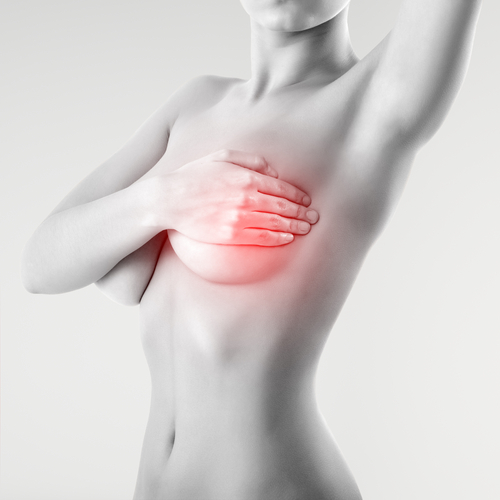Breast pain is extremely common and is rarely caused by cancer. This article explains how breast pain is investigated and treated.
Contents
- Introduction to what causes Breast Pain
- Clinical assessment of Mastalgia
- Investigation
- Cyclical mastalgia
- Non-cyclical mastalgia
- Summary
Introduction - What causes breast pain (Mastalgia)?

Mastalgia literally means 'pain in the region of the breast' and it is the most common symptom reported by women attending breast clinics. To make a full assessment of the cause of the pain, all patients require a full history, examination and, sometimes, further investigations. True breast pain can either be cyclical (getting worse before menstruation) or non-cyclical (unrelated to menstruation). It is important to point out that breast cancer does not usually cause mastalgia.
Clinical assessment of Mastalgia
Clinical evaluation of a patient with pain includes a detailed history to determine the nature, timing, duration and severity of the pain. The relationship to the menstrual cycle is very important in order to establish the cause of breast pain. Evaluating the impact of the pain on work and social activities is also very important. A patient’s history must include questions to assess the patient's risk of breast cancer such as the family history. This should be followed by a careful examination of the breasts and armpits. In the case of non-cyclical mastalgia, particular attention should be paid to non-breast causes of pain e.g. ribs, muscles, heart, stomach.
Investigation
Investigation of patients with breast pain should be directed to breast cancer screening. While mastalgia is not a usual symptom of breast cancer, it does present an opportunity for screening for this very common cancer in a context where there is generally poor access to medical care. However, radiological investigation is not necessary in young women with no risk factors, cyclical mastalgia, and a normal breast examination.
Digital mammography is recommended for women over 40, those with a positive family history and patients with non-cyclical mastalgia (older than 35).
If the physical examination or radiology identifies an abnormality such as a breast lump or symmetrical lumpiness, this must be fully investigated according to standard protocols, this includes a scan and needle biopsy. It is not uncommon for women presenting with mastalgia to have breast cancer as an incidental finding on screening.
Cyclical mastalgia
This type of breast pain typically occurs in young women (under 40 years old) in the days preceding each menstrual period. Women often report that the breasts feel heavy, larger in size and become generally uncomfortable. The cause of cyclical mastalgia is thought to be hormonal in nature and is related to abnormal fat levels in the blood. Women suffering from the condition are advised to use a pain chart (click on image below) to assess the duration and severity of the pain to help the doctor make the appropriate treatment decisions.
The doctor will usually perform a physical examination and inspect the pain chart. If no breast lump is found, the patient is reassured immediately. Such reassurance is sufficient to alleviate anxiety in the majority of cases. Women who suffer from pain lasting longer than seven days each month can be offered medical treatment.
Simple measures are usually attempted first, including the use of a well-fitting bra, a low-fat diet, flaxseed supplements, regular exercise and/or simple analgesics such as ibuprofen (tablet or local gel as required). If these fail to improve the symptoms, then the patient is advised to stop taking oral contraceptives.
If the pain is severe and persistent, then stronger drugs can be used, such as cabergoline and tamoxifen. However, these drugs can have side-effects such as weight gain and hot flushes. Tamoxifen (5 to 10 mg daily) is the most effective but should not be used for more than 6 months. Cyclical mastalgia usually improves with age.
Non-cyclical mastalgia
This refers to pain in the breast area that is unrelated to the menstrual cycle. Non-cyclical mastalgia may arise from the breast tissue itself, the underlying ribs, or from conditions such as hiatus hernia and angina. Although non-cyclical breast pain is not usually a symptom of cancer, occasionally, cancer has been detected in women with breast pain, especially if they are over 40 years old. Consequently, if you have non-cyclical mastalgia, it is important to consult your doctor.
Women with non-cyclical breast pain affecting one breast will require a breast examination and they should also have a mammogram if they are over 35 years old. Treatment will depend upon the cause of the pain. Inflammation in the ribs can be treated with simple painkillers, such as ibuprofen (tablet or gel), whereas other conditions, such as angina or hiatus hernia, will require specialist treatment.
The general treatment for non-cyclical mastalgia is listed below:
- Wear a well-fitting, firm bra.
- Optimise body weight and undertake regular exercise.
- Increase the amounts of fresh fruit and vegetables and reduce animal fat in your diet.
- Try flaxseed supplements.
- Try ibuprofen tablets or cream/gel.
- If there is a 'trigger spot' in the breast, then an injection of local anaesthetic and steroid will relieve symptoms in most cases.
- Discontinuing Hormone Replacement Therapy (HRT) may relieve severe mastalgia in some post-menopausal women.
- If the above measures fail and the breast pain is severe then it is worth trying tamoxifen (5 to 10 mg daily) or cabergoline (0.5 mg once weekly) under medical guidance and supervision.
Summary
Mastalgia, also known as pain in one or both breasts, is a common symptom and can be both cyclical and non-cyclical. All patients with mastalgia must be fully investigated and any chance of breast cancer established. The treatments for both cyclical and non-cyclical mastalgia can vary from changing your brassiere to receiving injections of local anaesthetic.
For further reading please see the article by Lydia Cairncross.
Mastalgia: mastalgia is one of the commonest breast symptoms presenting to general practitioners and surgeons. Continuing Medical Education 2010; 28(11)










